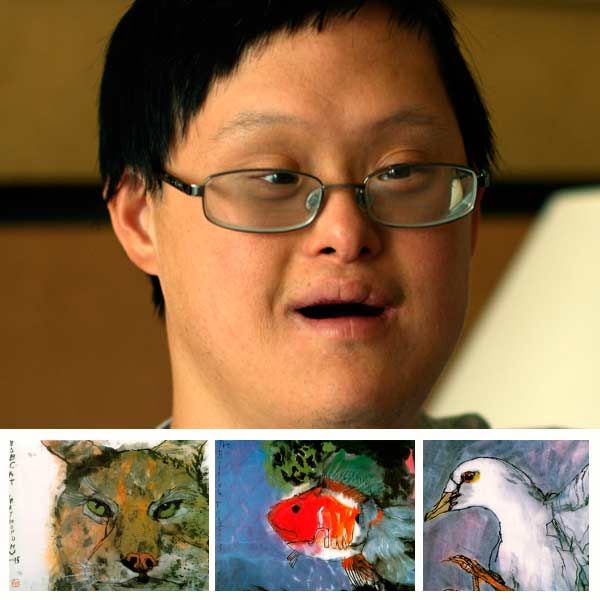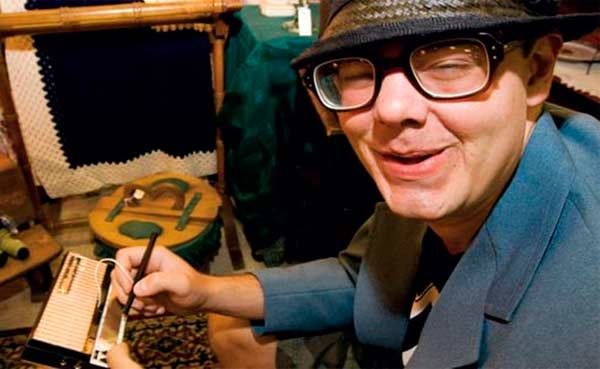Medical expert of the article
New publications
Mosaic form of Down syndrome: how to identify it
Last reviewed: 04.07.2025

All iLive content is medically reviewed or fact checked to ensure as much factual accuracy as possible.
We have strict sourcing guidelines and only link to reputable media sites, academic research institutions and, whenever possible, medically peer reviewed studies. Note that the numbers in parentheses ([1], [2], etc.) are clickable links to these studies.
If you feel that any of our content is inaccurate, out-of-date, or otherwise questionable, please select it and press Ctrl + Enter.

Genetic pathology caused by changes in chromosome 21 is mosaic Down syndrome. Let's consider its features, diagnostic methods, treatment and prevention.
Down syndrome is one of the most common congenital genetic disorders. It is characterized by severe mental retardation and a number of intrauterine anomalies. Due to the high birth rate of children with trisomy, many studies have been conducted. The pathology occurs in representatives of all peoples of the world, so no geographical or racial dependence has been established.
Epidemiology
According to medical statistics, Down syndrome occurs in 1 child out of 700-1000 births. The epidemiology of the disorder is associated with certain factors: hereditary predisposition, bad habits of parents and their age.
The pattern of disease distribution is not related to geography, gender, nationality or economic status of the family. Trisomy is caused by disturbances in the child's development.
Causes mosaic Down syndrome
The main causes of mosaic Down syndrome are related to genetic disorders. A healthy person has 23 pairs of chromosomes: female karyotype 46, XX, male 46, XY. One chromosome of each pair is passed on from the mother, and the other from the father. The disease develops as a result of quantitative disorder of autosomes, that is, extra genetic material is added to the 21st pair. Trisomy of chromosome 21 is responsible for the symptoms of the defect.
Mosaic syndrome can occur due to the following reasons:
- Somatic mutations in the zygote or at early stages of cleavage.
- Redistribution in somatic cells.
- Chromosome segregation during mitosis.
- Inheritance of a genetic mutation from the mother or father.
The formation of abnormal gametes may be associated with certain diseases of the genital area of the parents, radiation, smoking and alcoholism, taking medications or drugs, as well as with the environmental conditions of the place of residence.
About 94% of the syndrome is associated with simple trisomy, that is: karyotype 47, XX, 21+ or 47, XY, 21+. Copies of chromosome 21 are present in all cells, since during meiosis in the parental cells, the division of paired chromosomes is disrupted. About 1-2% of cases are due to disruption of mitosis of embryonic cells at the gastrula or blastula stage. Mosaicism is characterized by trisomy in the derivatives of the affected cell, while the rest have a normal chromosome set.
In the translocation form, which occurs in 4-5% of patients, chromosome 21 or its fragment is translocated to the autosome during meiosis, penetrating with it into the newly formed cell. The main objects of translocation are chromosomes 14, 15, and less often 4, 5, 13 or 22. Such changes can be random or inherited from a parent who is a carrier of the translocation and a normal phenotype. If the father has such disorders, the risk of having a sick child is 3%. If the mother is a carrier, the risk is 10-15%.
Risk factors
Trisomy is a genetic disorder that cannot be acquired during life. Risk factors for its development are not related to lifestyle or ethnicity. But the chances of having a sick child increase under the following circumstances:
- Late birth – women giving birth at the age of 20-25 have minimal chances of giving birth to a baby with the disease, but after 35 years the risk increases significantly.
- Father's age - many scientists claim that genetic disease depends not so much on the mother's age as on how old the father is. That is, the older the man, the higher the chances of pathology.
- Heredity – medicine knows of cases where the defect was inherited from close relatives, given that both parents are absolutely healthy. In this case, there is a predisposition only to certain types of the syndrome.
- Incest - marriages between blood relatives entail genetic mutations of varying severity, including trisomy.
- Bad habits - negatively affect the health of the future baby, so tobacco abuse during pregnancy can lead to a genomic anomaly. The same is observed with alcoholism.
There are suggestions that the development of the disorder may be related to the age at which the grandmother gave birth to the mother and other factors. Thanks to preimplantation diagnostics and other research methods, the risk of having a Down syndrome child is significantly reduced.
Pathogenesis
The development of a genetic disease is associated with a chromosomal abnormality, in which the patient has 47 chromosomes instead of 46. The pathogenesis of mosaic syndrome has a different development mechanism. The gamete sex cells of the parents have a normal number of chromosomes. Their fusion led to the formation of a zygote with a karyotype of 46, XX or 46, XY. During the division of the original cell, DNA failed, and the distribution was incorrect. That is, some cells received a normal karyotype, and some - a pathological one.
This type of anomaly occurs in 3-5% of cases of the disease. It has a positive prognosis, since healthy cells partially compensate for the genetic disorder. Such children are born with external signs of the syndrome and developmental delays, but their survival rate is significantly higher. They are less likely to have internal pathologies incompatible with life.
Symptoms mosaic Down syndrome
An abnormal genetic feature of the organism, which occurs when the number of chromosomes increases, has a number of external and internal signs. Symptoms of mosaic Down syndrome are manifested by delays in mental and physical development.
The main physical symptoms of the disease:
- Small and slow growing.
- Muscle weakness, decreased strength function, abdominal weakness (sagging belly).
- Short, thick neck with folds.
- Short limbs and a large distance between the big and index toes.
- A specific skin fold on the palms of children.
- Low set and small ears.
- Distorted shape of the tongue and mouth.
- Crooked teeth.
The disease causes a number of developmental and health problems. First of all, it is cognitive retardation, heart defects, problems with teeth, eyes, back, hearing. Tendency to frequent infectious and respiratory diseases. The degree of manifestations of the disease depends on congenital factors and properly selected treatment. Most children are able to learn, despite mental, physical and psychological retardation.
First signs
Mosaic Down syndrome has less pronounced symptoms, unlike the classic form of the disorder. The first signs can be seen on ultrasound at 8-12 weeks of pregnancy. They are manifested by an increase in the collar zone. But ultrasound does not give a 100% guarantee of the presence of the disease, but allows you to assess the likelihood of developmental defects in the fetus.
The most characteristic are external symptoms, with their help doctors presumably diagnose the pathology immediately after the baby is born. The defect is characterized by:
- Slanted eyes.
- "Flat" face.
- Short-headedness.
- Thickened cervical skin fold.
- A semilunar fold at the inner corner of the eyes.
Further examination reveals the following problems:
- Decreased muscle tone.
- Increased joint mobility.
- Deformation of the chest (keeled, funnel-shaped).
- Broad and short bones, flat occiput.
- Deformed ears and wrinkled nose.
- Small arched sky.
- Pigmentation along the edge of the iris.
- Transverse palmar crease.
In addition to external symptoms, the syndrome also has internal disorders:
- Congenital heart defects and other disorders of the cardiovascular system, anomalies of large vessels.
- Pathologies of the respiratory system caused by the structural features of the oropharynx and large tongue.
- Strabismus, congenital cataracts, glaucoma, hearing impairment, hypothyroidism.
- Gastrointestinal disorders: intestinal stenosis, atresia of the anus and rectum.
- Hydronephrosis, renal hypoplasia, hydroureter.
The above symptoms require constant treatment to maintain the normal state of the body. It is congenital defects that are the reason for the short life of Downs.
 [ 18 ]
[ 18 ]
External signs of mosaic Down syndrome
In most cases, the external signs of mosaic Down syndrome appear immediately after birth. Due to the high prevalence of genetic pathology, its symptoms have been studied and described in detail.
Changes in chromosome 21 are characterized by the following external signs:
- Abnormal structure of the skull.
This is the most noticeable and pronounced symptom. Normally, babies have a larger head than adults. Therefore, any deformations are visible immediately after birth. The changes concern the structure of the cranium and facial skull. The patient has a disproportion in the area of the crown bones. There is also a flattening of the back of the head, a flat face and pronounced ocular hypertelorism.
- Developmental disorders of the eyes.
A person with this disease resembles a representative of the Mongoloid race. Such changes appear immediately after birth and persist throughout life. In addition, it is worth noting strabismus in 30% of patients, the presence of a skin fold at the inner corner of the eyelid and pigmentation of the iris.
- Congenital defects of the oral cavity.
Such disorders are diagnosed in 60% of patients. They create difficulties in feeding the child, slowing down its growth. A person with the syndrome has an altered tongue surface due to a thickened papillary layer (grooved tongue). In 50% of cases, there is a Gothic palate and impaired sucking reflex, a half-open mouth (muscle hypotonia). In rare cases, anomalies such as "cleft palate" or "hare lip" are observed.
- Incorrect shape of ears.
This disorder occurs in 40% of cases. Underdeveloped cartilages form an abnormal auricle. The ears may stick out in different directions or be located below eye level. Although the defects are cosmetic, they can cause serious hearing problems.
- Additional skin folds.
Occurs in 60-70% of patients. Each skin fold is caused by underdevelopment of bones and their irregular shape (the skin does not stretch). This external sign of trisomy manifests itself as excess skin on the neck, thickening in the elbow joint and a transverse fold on the palm.
- Pathologies of the development of the musculoskeletal system
They arise due to a violation of intrauterine development of the fetus. The connective tissue of the joints and some bones do not have time to fully form before birth. The most common anomalies are: a short neck, increased joint mobility, short limbs and deformed fingers.
- Chest deformity.
This problem is associated with underdevelopment of bone tissue. Patients have deformation of the thoracic spine and ribs. Most often, a protruding sternum above the surface of the chest is diagnosed, that is, a keel-shaped form and a deformation in which there is a funnel-shaped depression in the solar plexus area. Both disorders persist as the child grows older and taller. They provoke disorders in the structure of the respiratory system and the cardiovascular system. Such external symptoms indicate a poor prognosis for the disease.
The main feature of the mosaic form of Down syndrome is that many of the above symptoms may be absent. This complicates the differentiation of the pathology from other chromosomal abnormalities.
Forms
The syndrome has several types, let's consider them:
- Mosaic - the extra chromosome is not present in all cells of the body. This type of disease accounts for 5% of all cases.
- Familial – occurs in 3% of patients. Its peculiarity is that each of the parents has a number of deviations that are not expressed externally. During intrauterine development, part of the 21st chromosome is attached to another, making it a pathological carrier of information. Parents with this defect give birth to children with the syndrome, that is, the anomaly is inherited.
- Duplication of part of chromosome 21 is a rare type of disease, the peculiarity of which is that chromosomes are not able to divide. That is, additional copies of chromosome 21 appear, but not in all genes. Pathological symptoms and external manifestations develop if fragments of genes are duplicated, which cause the clinical picture of the defect.
 [ 22 ]
[ 22 ]
Complications and consequences
Chromosomal mosaicism causes consequences and complications that negatively affect health and significantly worsen the prognosis of the disease.
Let's look at the main dangers of trisomy:
- Cardiovascular pathologies and heart defects. About 50% of patients have congenital defects that require surgical treatment at an early age.
- Infectious diseases – defects in the immune system provoke increased sensitivity to various infectious pathologies, especially colds.
- Obesity – people with the syndrome have a greater tendency to be overweight than the general population.
- Diseases of the hematopoietic system. Downs suffer from leukemia more often than healthy children.
- Short life expectancy – the quality and duration of life depends on the severity of congenital diseases, consequences and complications of the disease. Back in the 1920s, people with the syndrome did not live to be 10 years old, today the age of patients reaches 50 years and older.
- Dementia is a mental decline and persistent decline in cognitive function associated with the accumulation of abnormal proteins in the brain. Symptoms of the disorder occur in patients under 40 years of age. This disorder is characterized by a high risk of seizures.
- Sleep apnea is a condition in which breathing stops during sleep due to abnormal soft tissue and skeletal structure that is susceptible to airway obstruction.
In addition to the complications described above, trisomy is characterized by thyroid problems, weak bones, poor vision, hearing loss, early menopause, and intestinal obstruction.
Diagnostics mosaic Down syndrome
Genetic pathology can be detected even before birth. Diagnosis of mosaic Down syndrome is based on the study of the karyotype of blood and tissue cells. In the early stages of pregnancy, a chorion biopsy is performed, which allows identifying signs of mosaicism. According to statistics, only 15% of women who learn about genetic abnormalities in a child decide to keep it. In other cases, premature termination of pregnancy is indicated - abortion.
Let's consider the most reliable methods for diagnosing trisomy:
- Biochemical blood test – blood for the study is taken from the mother. The biological fluid is assessed for the level of β-hCG and plasma protein A. In the second trimester, another test is performed to monitor the level of β-hCG, AFP and free estriol. Reduced AFP levels (a hormone produced by the liver of the fetus) are highly likely to indicate a disease.
- Ultrasound examination – is carried out in each trimester of pregnancy. The first allows to detect: anencephaly, cervical hygroma, determine the thickness of the collar zone. The second ultrasound makes it possible to track heart defects, anomalies in the development of the spinal cord or brain, disorders of the gastrointestinal tract, hearing organs, kidneys. In the presence of such pathologies, termination of pregnancy is indicated. The last study, carried out in the third trimester, can reveal minor disorders that can be eliminated after childbirth.
The above studies allow us to estimate the risk of having a child with the syndrome, but they do not provide an absolute guarantee. At the same time, the percentage of erroneous diagnostic results carried out during pregnancy is small.
Tests
Diagnosis of genomic pathology begins during the period of gestation. Tests are performed in the early stages of pregnancy. All studies for the presence of trisomy are called screenings or screenings. Their questionable results allow us to suspect the presence of mosaicism.
- First trimester – up to 13 weeks, an analysis is performed for hCG (human chorionic gonadotropin) and the PAPP-A protein, i.e. substances secreted only by the fetus. If the disease is present, hCG is elevated and the PAPP-A level is reduced. With such results, an amnioscopy is performed. Tiny particles of the chorion are extracted from the uterine cavity of the pregnant woman through the cervix.
- Second trimester – tests for hCG and estriol, AFP and inhibin-A. In some cases, genetic material is examined. To collect it, a puncture of the uterus is made through the abdomen.
If the test results indicate a high risk of trisomy, the pregnant woman is referred to a geneticist.
Instrumental diagnostics
Instrumental diagnostics are indicated to detect intrauterine pathologies in the fetus, including mosaicism. If Down syndrome is suspected, screenings are performed throughout the pregnancy, as well as an ultrasound examination to measure the thickness of the posterior part of the fetal neck.
The most dangerous method of instrumental diagnostics is amniocentesis. This is a study of amniotic fluid, which is carried out at a period of 18 weeks (a sufficient volume of fluid is required). The main danger of this analysis is that it can lead to infection of the fetus and mother, rupture of the amniotic sac and even miscarriage.
What tests are needed?
Differential diagnosis
Mosaic changes in chromosome 21 require careful examination. Differential diagnostics of Down syndrome is carried out with the following pathologies:
- Klinefelter syndrome
- Shereshevsky-Turner syndrome
- Edwards syndrome
- De La Chapelle's syndrome
- Congenital hypothyroidism
- Other forms of chromosomal abnormalities
In some cases, mosaicism of the sex chromosomes XX/XY leads to true hermaphroditism. Differentiation is also necessary for mosaicism of the gonads, which are a special case of organ pathology that occurs at the late stages of embryonic development.
Who to contact?
Treatment mosaic Down syndrome
Therapy for chromosomal diseases is impossible. Treatment for mosaic Down syndrome is lifelong. It is aimed at eliminating developmental defects and associated diseases. A person with this diagnosis is under the supervision of such specialists: pediatrician, psychologist, cardiologist, psychiatrist, endocrinologist, ophthalmologist, gastroenterologist and others. All treatment is aimed at social and family adaptation. The task of parents is to teach the baby complete self-care and contact with others.
Treatment and rehabilitation of Down syndrome patients consists of the following procedures:
- Massages – the muscular system of both the infant and the adult with this syndrome is underdeveloped. Special gymnastics helps restore muscle tone and maintains them in a normal state. Particular attention is paid to hydromassages. Swimming and water gymnastics improve motor skills and strengthen muscles. Dolphin therapy is popular, when the patient swims with dolphins.
- Dietitian consultations – patients with trisomy have problems with excess weight. Obesity can provoke various disorders, the most common being cardiovascular and digestive tract disorders. The dietitian gives nutritional recommendations and, if necessary, prescribes a diet.
- Consultations with a speech therapist – mosaicism, like other types of syndrome, is characterized by speech development disorders. Sessions with a speech therapist will help the patient express his thoughts correctly and clearly.
- Special training program – children with the syndrome lag behind their peers in development, but they are teachable. With the right approach, the child can master basic knowledge and skills.
Patients are prescribed general strengthening therapy, very often psychostimulants, neurometabolic and hormonal drugs are prescribed. Regular intake of vitamins is also necessary. All drug therapy is combined with medical and pedagogical correction. Congenital pathologies and complex diseases require surgical intervention.
Prevention
There are currently no reliable methods for preventing genetic diseases. Prevention of mosaic Down syndrome consists of the following recommendations:
- Timely treatment of any diseases and a healthy lifestyle. Increased activity improves blood circulation, protecting the eggs from oxygen starvation.
- Proper nutrition and normal weight. Vitamins, minerals and other nutrients not only strengthen the immune system, but also maintain hormonal balance. Excess weight or excessive thinness disrupt hormonal balance and provoke failures in the maturation and development of reproductive cells.
- Preparing for pregnancy. A couple of months before the planned conception, you need to consult a gynecologist and start taking vitamin and mineral complexes. Particular attention should be paid to folic acid, vitamins B and E. They normalize the functioning of the genitals and improve metabolic processes in the sex cells. Do not forget that the risk of giving birth to a child with abnormalities increases in couples where the age of the expectant mother is over 35 years old, and the father is over 45.
- Prenatal diagnostics. Tests, screenings and a number of other diagnostic procedures performed during pregnancy allow identifying serious disorders in the fetus and making a decision on further gestation or abortion.
But even the implementation of all preventive measures cannot give a 100% guarantee of the birth of a completely healthy baby. Trisomy is a random genetic anomaly, from which no woman is immune.
Forecast
Mosaic Down syndrome has a more positive outcome, unlike the classic form of pathology. The prognosis is due to the fact that healthy cells partially compensate for the genetic defect. But the child will still have external signs of trisomy and the developmental delay characteristic of it. But the survival rate of such patients is much higher, they are less likely to have developmental defects that are incompatible with life.
 [ 31 ]
[ 31 ]
Famous People with Mosaic Down Syndrome
Changes in the 21st chromosome lead to irreversible consequences that cannot be treated. But despite this, among those born with trisomy there are artists, musicians, writers, actors and many other accomplished personalities. Famous people with mosaic Down syndrome boldly declare their illness. They are a vivid example of the fact that, if desired, any problem can be overcome. The following celebrities have this genomic disorder:
- Jamie Brewer is an actress known for her role in the TV series American Horror Story. The girl not only acts in films, she is also a model. Jamie participated in the Mercedes-Benz Fashion Week show in New York.

- Raymond Hu is a young artist from California, USA. The peculiarity of his paintings is that he draws them using an ancient Chinese technique: on rice paper, with watercolors and ink. The guy's most popular works are portraits of animals.

- Pascal Duquenne is an actor and winner of the Silver Prize at the Cannes Film Festival. He became famous thanks to his role in Jaco van Dormel's film "The Eighth Day".

- Ronald Jenkins is a world-famous composer and musician. His love for music began with a synthesizer he received as a child for Christmas. Today, Ronald is rightfully considered a genius of electronic music.

- Karen Gafni is a teaching assistant and an athlete. She is a swimmer and has participated in the English Channel Marathon. She became the first person with mosaicism to swim 15 km in water at 15°C. Karen has her own charity foundation that represents the interests of people with chromosomal abnormalities.
- Tim Harris is a restaurateur who owns "the friendliest restaurant in the world." In addition to a delicious menu, Tim's establishment offers free hugs.

- Miguel Tomasin is a member of the Reynols group, a drummer, and a guru of experimental music. The guy performs both his own songs and covers of famous rock musicians. He is involved in charity work, performing in centers and concerts to support sick children.

- Bohdan Kravchuk is the first person with Down syndrome in Ukraine to enter a university. The guy lives in Lutsk, is interested in science, and has many friends. Bohdan entered the Lesya Ukrainka East European National University in the history department.

As practice and real examples show, despite all the complications and problems of genetic pathology, with the right approach to its correction, it is possible to raise a successful and talented child.

